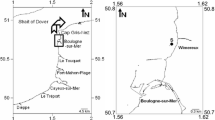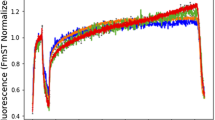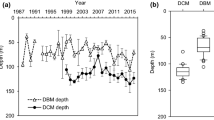Abstract
Fast repetition rate fluorometry (FRRF) was successfully applied to various studies in modern oceanography. In this study, for the first time, the seasonality of phytoplankton photosynthetic parameters in a deep alpine lake was observed using FRRF in combination with the traditional 14C incubation technique. Special attention was given to the differences in photosynthetic behaviour during mixed and stratified conditions, characterised especially during summer by a deep chlorophyll maximum (DCM) dominated by the filamentous cyanobacterial species Planktothrix rubescens. Maximum light-utilisation efficiency (α*14C) was in the range of 0.01–0.03 mgC (mg Chl-a)−1 h−1 (μmol phot. m−2 s−1)−1, while maximum quantum yields for carbon fixation (ΦC,max) varied from 0.01–0.07 molC (mol phot.)−1. Higher values occurred during thermal stratification indicating acclimation of the phytoplankton assemblage. These findings were supported by FRRF-based estimates, although cyanobacterial blooms could not be characterised by FRRF-excitation due to methodological deficiencies. In general, however, instantaneous photosynthetic rates measured by FRRF-excitation correlate well at sub-saturating light-intensities with conventional 14C-uptake rates, although they operate on different time-scales.
Similar content being viewed by others
References
Arbones B, Figueiras FG, Varela R, (2000) Action spectrum and maximum quantum yield of carbon fixation in natural phytoplankton populations: implications for primary production estimates in the oceanJ Mar Syst 26: 9–114
Babin M, Morel A, Claustre H, Bricaud A, Kolber Z, Falkowski PG, (1996) Nitrogen and irradiance variations in the maximum quantum yield of carbon fixation in eutrophic, mesotrophic and oligotrophic marine systemsDeep Sea Res Part 1 Oceanogr Res Pap 43: 1241–1272
Babin M, Therriault JC, Legendre L, Nieke B, Reuter R, Condal A, (1995) Relationship between the maximum quantum yield of carbon fixation and the minimum quantum yield of chlorophyll a in vivo fluorescence in the Gulf of St. LawrenceLimnol Oceanogr 40: 956–968
Behrenfeld MJ, Kolber ZS, (1999) Widespread iron limitation of phytoplankton in the South Pacific OceanScience 283: 840–843
Behrenfeld MJ, Bale AJ, Kolber ZS, Aiken J, Falkowski PG, (1996) Confirmation of iron limitation of phytoplankton photosynthesis in the equatorial pacific oceanNature 383: 508–511
Behrenfeld MJ, Prásil O, Kolber ZS, Babin M, Falkowski PG, (1998) Compensatory changes in Photosystem II electron turnover rates protect photosynthesis from photoinhibitionPhotosynth Res 58: 259–268
Bender M, Grande K, Johnson K, Marra J, Williams PJ LeB, Sieburth J, Pilson M, Langdon M, Hitchcock G, Orchado J, Hunt C, Donaghay P, Heinemann K, (1987) A comparison of four methods for determining planktonic community productionLimnol Oceanogr 32: 1085–1098
Berges JA, Charlebois DO, Mauzerall DC, Falkowski PG, (1996) Differential effects of nitrogen limitation on photosynthetic efficiency in photosystems I and II in microalgaePlant Physiol (Rockv) 110: 689–696
Boyd PW, Aiken J, Kolber Z, (1997) Comparison of radiocarbon and fluorescence based (pump and probe) measurements of phytoplankton photosynthetic characteristics in the North East Atlantic OceanMar Ecol Prog Ser 149: 215–226
Bracher AU, Wiencke C, (2000) Simulation of the effects of naturally enhanced UV radiation on photosynthesis of Antarctic phytoplanktonMar Ecol Prog Ser 196: 127–141
Bryant DA, (1982) Phycoerythrocyanin and phycoerythrin: properties and occurrence in cyanobacteriaJ Gen Microbiol 128: 835–844
Cunningham A, (1996) Variability of in vivo chlorophyll fluorescence and its implications for instrument development in biooptical oceanographySci Mar 60: 309–315
Danieri G, Iriarte A, Garcia VM, Purdie DA, Crawford DW, (1992) Growth irradiance as a factor controlling the dark respiration rates of marine phytoplanktonJ Mar Biol Assoc UK 72: 723–726
DIN 38 412 (1984) Testverfahren mit Wasserorganismen. Bestimmung des Chlorophyll a Gehaltes von Oberflächenwasser. Deutsche Einheitsverfahren, Berlin, pp. 4
Dokulil M, (1987) Long C. term occurrence of blue-green algae in Mondsee during eutrophication and after nutrient reduction with special reference to Oscillatoria rubescens – SchweizZ Hydrol 49: 378
Dokulil MT, (1993) Long-term response of phytoplankton population dynamics to oligotrophication in Mondsee, AustriaVerh Internat Verein Limnol 25: 657–661
Dokulil M, Skolaut C, (1986) Succession of phytoplankton in a deep stratifying lake: Mondsee, AustriaHydrobiologia 138: 9–24
Dokulil MT, Teubner K, (2003) Steady state phytoplankton assemblages during thermal stratification in deep alpine lakes. Do they occur? Hydrobiologia 502: 65–72
Eppley RW (1980) Estimating phytoplankton growth rates in the central oligotrophic oceans. In: Primary Production in the Sea. Plenum Press. Brookhaven Symp Biol 31: 231–242
Falkowski PG, (1983) Light-shade adaptation and vertical mixing of marine phytoplankton: a comparative field studyJ Mar Res 41: 215–237
Falkowski PG, (1995) Variations in chlorophyll fluorescence yields in phytoplankton in the world oceansAust J Plant Physiol 22: 341–355
Falkowski PG, Wyman K, Ley AC, Mauzerall DC, (1986) Relationship of steady state photosynthesis to fluorescence in eucaryotic algaeBiochim Biophys Acta 849: 183–192
Findenegg I, (1969) Die Eutrophierung des Mondsees im SalzkammergutWasser- und Abwasser-Forschung 4: 139–144
Flameling IA, Kromkamp J, (1998) Light dependence of quantum yields for PS II charge separation and oxygen evolution in eucaryotic algaeLimnol Oceanogr 43: 284–297
Geider RJ, Greene RM, Kolber Z, Macintyre HL, Falkowski PG, (1993) Fluorescence assessment of the maximum quantum efficiency of photosynthesis in the Western North – AtlanticDeep Sea Res 40: 1205–1224
Golterman HL, Clymo RS, Ohnstad MAM, (1978) Methods for Physical and Chemical Analysis of Fresh Waters. IBP Handbook No. 8. Blackwell Sci Publ, Oxford, UK. 213pp
Gorbunov MY, Kolber ZS, Falkowski PG, (2000) Measurement of photosynthetic parameters in benthic organisms in situ using a SCUBA-based fast repetition rate fluorometerLimnol Oceanogr 45: 242–245
Grande K, Marra DJ, Langdon C, Heinemann K, Bender ML, (1989) Rates of respiration in the light measured using an 18O isotope labelling techniqueJ Exp Mar Ecol 129: 95–120
Greenberg AE, Clesceri LS and Eaton AD (eds) (1992) Standard Methods for the Examination of Water and Wastewater. Amea Publ Helth Assoc, Washington DC
Greene RM, Kolber ZS, Swift DG, Tindale NW, Falkowski PG, (1994) Physiological limitation of phytoplankton photosynthesis in the eastern Equatorial Pacific determined from variability in the quantum yield of fluorescenceLimnol Oceanogr 39: 1061–1074
Jassby AD, Platt T, (1976) Mathematical formulation of the relationship between photosynthesis and light in phytoplanktonLimnol Oceanogr 21: 540–547
Kana TM, (1992) Relationship between photosynthetic oxygen cycling and carbon assimilation in Synechococcus WH7803 (Cyanophyta)J Phycol 28: 304–308
Kana TM, (1993). Rapid oxygen cycling in Trichodesmium thiebautiiLimnol Oceanogr 38: 18–24
Kishino M, Okami N, Takahashi M, Ichimura S, (1986) Light utilisation efficiency and quantum yield of phytoplankton in a thermally stratified seaLimnol Oceanogr 31: 557–566
Kolber ZS, Barber RT, Coale KH, Fitzwater SE, Greene RM, Johnson KS, Lindley S, Falkowski PG, (1994) Iron limitation of phytoplankton photosynthesis in the equatorial Pacific OceanNature 371: 145–149
Kolber ZS, Falkowski PG, (1993) Use of active fluorescence to estimate phytoplankton photosynthesis in situLimnol Oceanogr 38: 1646–1665
Kolber ZS, Prasil O, Falkowski PG, (1998) Measurements of variable chlorophyll fluorescence using fast repetition rate techniques: defining methodology and experimental protocolsBiochem Biophys Acta 1367: 88–106
Kolber ZS, Wyman KD, Falkowski PG, (1990) Natural variability in photosynthetic energy conversion efficiency; a field study in the Gulf of MaineLimnol Oceanogr 35: 72–79
Kolber ZS, Zehr J, Falkowski PG, (1988) Effects of growth irradiance and nitrogen limitation on photosynthetic energy conversion in photosystem IIPlant Physiol 88: 923–929
Kromkamp JC, Domin A, Dubinski Z., Lehmann C, Schanz F, (2001) Changes in photosynthetic properties measured by oxygen evolution and variable chlorophyll fluorescence in a simulated entrainment experiment wit the cyanobacterium Planktothrix rubescensAquat Sci 63: 363–382
Lesser PL, Gorbunov MJ, (2001) Diurnal and bathymetric changes in chlorophyll fluorescence yields of reef corals measured in situ with a fast repetition rate fluorometerMar Ecol Prog Ser 212: 69–77
Lorenzen CJ, (1967) Determination of chlorophyll and phaeo-pigments: spectrophotometric equationsLimnol Oceanogr 12: 343–346
Marra J, (2002) Approaches to the measurement of phytoplankton production. In: Williams PJ LeB, Thomas DN, Reynolds CS, (eds.) Phytoplankton Productivity. Blackwell Science, Oxford, p 78–108
McMinn A, Hegseth EN, (2004) Quantum yield and photosynthetic parameters of marine microalgae from the southern Arctic Ocean, SvalbardJ Mar Biol Ass UK 84: 865–871
Moore CM, Suggett D, Holligan PM, Sharples J, Abraham ER, Lucas MI, Rippeth TP, Fisher NR, Simpson JH, Hydes DJ, (2003) Physical controls on phytoplankton physiology and production at a shelf sea front: a fast repetition-rate fluorometer based field studyMar Ecol Prog Ser 259: 29–45
Olaizola M, LaRoche J, Kolber ZS, Falkowski PG, (1994) Non photochemical quenching and the diadinoxanthin cycle in a marine diatom. Photosynth Res 41: 357–370
Olson RJ, Chekalyuk AM, Sosik HM, (1996) Phytoplankton photosynthetic characteristics from fluorescence induction essays of individual cellsLimnol Oceanogr 41: 1253–1263
Prasil OZ, Kolber ZS, Berry JA, Falkowski PG, (1996) Cyclic electron flow around photosystem II in vivoPhotosynth Res 48: 395–410
Raateoja M, Seppälä J, Kuosa H, (2004a) Bio-optical modelling of primary production in the SW Finnish coastal zone, Baltic Sea: fast repetition rate fluorometry in Case 2 watersMar Ecol Prog Ser 267: 9–26
Raateoja M, Seppälä J, Ylöstalo P, (2004b) Fast repetition rate fluorometry is not applicable to studies of filamentous cyanobacteria from the Baltic SeaLimnol Oceanogr 49: 1006–1012
Schindler DW, Schmidt RV, Reid RA, (1972) Acidification and bubbling as an alternative in determining phytoplankton production by the 14C methodJ Fish Res Board Canada 29: 1627–1631
Sidler WA (1994) Phycobilisome and phycobiliprotein structure. In: Bryant DA (ed) The Molecular Biology of Cyanobacteria, pp 139–216. Kluwer Academic Publishers, Dordrecht, The Netherlands
Smyth TJ, Pemberton KI, Aiken J, Geider RJ, (2004) A methodology to determine primary production and phytoplankton photosynthetic parameters from Fast Repetition Rate FluorometryJ Plankton Res 26: 1337–1350
Steemann-Nielsen E, (1952) The use of radioactive carbon (C14) for measuring organic production in the seaJ Cons Int de laMer 18: 117–140
Strutton PG, Mitchell JG, Parslow JS, Greene RM, (1997) Phytoplankton patchiness: quantifying the biological contribution using fast repetition rate fluorometryJ Plankton Res 19: 1265–1274
Suggett D, Kraay G, Holligan P, Davey M, Aiken J, Geider R, (2001) Assessment of a spring cyanobacterial bloom by use of a fast repetition rate fluorometerLimnol Oceanogr 46: 802–810
Teubner K, Tolotti M, Greisberger S, Morscheid H, Dokulil MT, Morscheid H, (2003). Steady state phytoplankton in a deep pre-alpine lake: species and pigments of epilimnetic versus metalimetic assemblagesHydrobiologia 502: 49–64
Utermöhl H (1958) Zur Vervollkommnung der Quantitativen Phytoplanktonmethodik.Verh Internat Verein Limnol 9: Stuttgart
Weger HG, Herzig R, Falkowski PG, Turpin DH, (1989) Respiratory losses in the light in a marine diatom: measurements by short-term mass spectrometryLimnol Oceanogr 34: 1153–1161
Acknowledgements
We thank Katrin Teubner (Intitute for Limnology, Mondsee) for advice and discussion, and Anika Stracke (Intitute for Limnology, Mondsee) for technical support and company on sampling tours and in the laboratory. Also, we want to thank Robert de Paoli and Steve Juggins (both Chelsea Instruments, UK) for uncomplicated, quick technical support handling serious struggles with the Fluorometer. We thank two anonymous reviewers for comments to strenghten the manuscript.
Author information
Authors and Affiliations
Corresponding author
Rights and permissions
About this article
Cite this article
Kaiblinger, C., Dokulil, M.T. Application of fast repetition rate fluorometry to phytoplankton photosynthetic parameters in freshwaters. Photosynth Res 88, 19–30 (2006). https://doi.org/10.1007/s11120-005-9018-8
Received:
Accepted:
Published:
Issue Date:
DOI: https://doi.org/10.1007/s11120-005-9018-8




